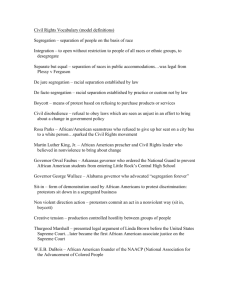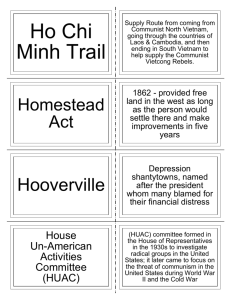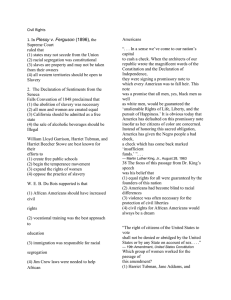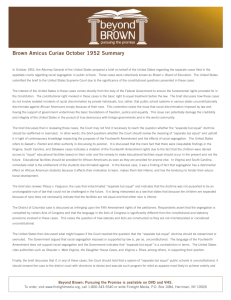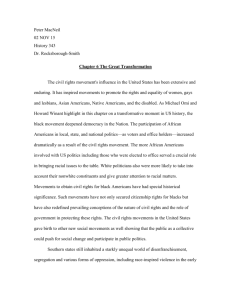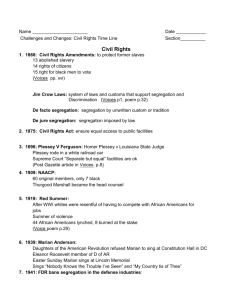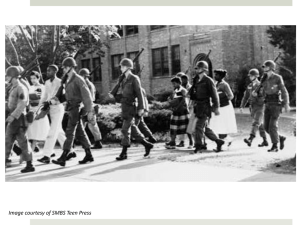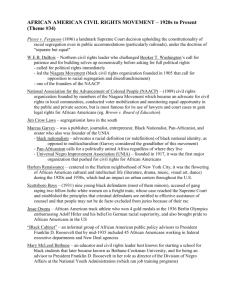Practice Final 2
advertisement
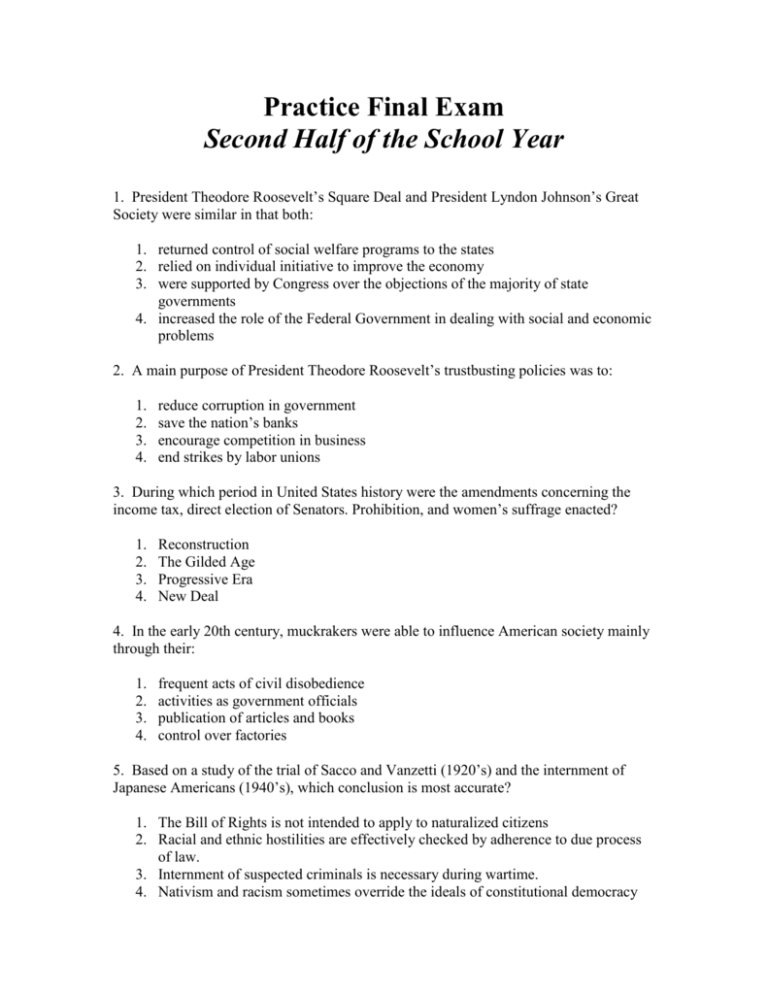
Practice Final Exam Second Half of the School Year 1. President Theodore Roosevelt’s Square Deal and President Lyndon Johnson’s Great Society were similar in that both: 1. returned control of social welfare programs to the states 2. relied on individual initiative to improve the economy 3. were supported by Congress over the objections of the majority of state governments 4. increased the role of the Federal Government in dealing with social and economic problems 2. A main purpose of President Theodore Roosevelt’s trustbusting policies was to: 1. 2. 3. 4. reduce corruption in government save the nation’s banks encourage competition in business end strikes by labor unions 3. During which period in United States history were the amendments concerning the income tax, direct election of Senators. Prohibition, and women’s suffrage enacted? 1. 2. 3. 4. Reconstruction The Gilded Age Progressive Era New Deal 4. In the early 20th century, muckrakers were able to influence American society mainly through their: 1. 2. 3. 4. frequent acts of civil disobedience activities as government officials publication of articles and books control over factories 5. Based on a study of the trial of Sacco and Vanzetti (1920’s) and the internment of Japanese Americans (1940’s), which conclusion is most accurate? 1. The Bill of Rights is not intended to apply to naturalized citizens 2. Racial and ethnic hostilities are effectively checked by adherence to due process of law. 3. Internment of suspected criminals is necessary during wartime. 4. Nativism and racism sometimes override the ideals of constitutional democracy 6. One way in which the Red Scare of the 1920s and McCarthyism of the 1950s were similar is that both: 1. 2. 3. 4. jeopardized the rights of individuals suspected of un-American activity occurred during times of economic depression addressed the issue of increased government bureaucracy after a world war led to the imprisonment of ethnic minorities during wartime 7. The Harlem Renaissance of the 1920’s was a period when African Americans: 1. 2. 3. 4. left the United States in large numbers to settle in Nigeria created noteworthy works of art and literature migrated to the West in search of land and jobs used civil disobedience to fight segregation in the Armed Forces 8. The 1920’s are sometimes called the "Roaring Twenties" because: 1. 2. 3. 4. foreign trade prospered after World War I the United States assumed a leadership role in world affairs political reforms made government more democratic widespread social and economic change occurred 9. The economic boom and the financial speculation of the 1920’s were caused in part by: 1. 2. 3. 4. installment buying and an unregulated stock market the expansion of civil rights to women and minorities the mobilization of the economy for war increased government restrictions on big business 10. Which combination of factors contributed most to the start of the Great Depression of the 1930’s? 1. 2. 3. 4. immigration restrictions and a lack of skilled workers high taxes and overspending on social welfare programs United States war debts and the declining value of the dollar overproduction and the excessive use of credit 11. During World War II, women and minorities made economic gains mainly because: 1. a shortage of traditional labor created new opportunities in the workplace 2. more educational opportunities increased the number of skilled workers in these groups 3. labor unions successfully demanded equal opportunities for these groups 4. new civil rights legislation forced businesses to change their hiring practices 12. A major cause of the internment of Japanese Americans during World War II was: 1. 2. 3. 4. national segregation policies immigration quotas racial prejudice economic depression 13. President Harry Truman’s decision to use atomic bombs against Japan was primarily based on his belief that: 1. 2. 3. 4. an invasion of Japan would result in excessive casualties Germany would refuse to surrender in Europe an alliance was developing between Japan and the Soviet Union Japan was in the process of developing its own atomic weapons 14. Which congressional action not only raised money for World War II but also contributed to the national debt? 1. 2. 3. 4. requiring employers to withhold taxes from workers’ paychecks raising income tax rates selling war bonds enacting wage and price controls 15. Which situation resulted from Senator Joseph McCarthy’s search for Communists within the United States during the 1950’s? 1. Thousands of American citizens who believed in communism were either jailed or deported. 2. The reputations of many people were ruined by false accusations of disloyalty 3. Many high-ranking government officials were exposed as spies of the Soviet Union. 4. Organized groups of Communists began a wave of violent political terrorism. 16. The successful launching of Sputnik by the Soviet Union in 1957 signaled the beginning of: 1. 2. 3. 4. American fears that the Soviets had achieved technological superiority the Cold War with the United States Soviet aggression in Afghanistan and China disarmament discussions between the superpowers 17. The Truman Doctrine and the Marshall Plan represented attempts by the United States to deal with the: 1. 2. 3. 4. national debt spread of communism President’s political opposition arms race 18. Both the Bay of Pigs invasion of Cuba (1961) and the invasion of Panama (1989) are examples of United States attempts to: 1. 2. 3. 4. eliminate unfriendly governments geographically close to the United States cultivate good relations with Latin American nations stop the drug trade end the Cold War 19. The Korean War and the Persian Gulf War were similar in that both: 1. 2. 3. 4. represented United Nations efforts to assist nations in repelling aggressors involved unilateral military action by the United States were military defeats for the United Nations brought about lasting solutions to problems in each region 20. President John F. Kennedy supported the 1961 Bay of Pigs invasion of Cuba as an effort to: 1. 2. 3. 4. remove a communist dictator from power stop the flow of illegal drugs to the United States support Fidel Castro’s efforts for reform rescue hostages held by Cuban freedom fighters 21. The major goal of the civil rights movement of the 1960’s was to: 1. 2. 3. 4. establish a separate political state for African Americans gain passage of an equal rights amendment to the Constitution end segregation based on race permit unlimited immigration to the United States 22. When necessary to achieve justice, which method did Martin Luther King, Jr., urge his followers to employ? 1. 2. 3. 4. using violence to bring about political change engaging in civil disobedience leaving any community in which racism is practiced demanding that Congress pay reparations to African Americans 23. After the passage of the 13th, 14th, and 15th amendments, African Americans continued to experience political and economic oppression mainly because: 1. 2. 3. 4. the amendments were not intended to solve their problems many African Americans distrusted the Federal Government Southern legislatures enacted Jim Crow laws poor communications kept people from learning about their legal rights 24. Martin Luther King, Jr. first emerged as a leader of the civil rights movement when he: 1. 2. 3. 4. led the bus boycott in Montgomery, Alabama refused to give up his seat on a bus to a white man challenged the authority of the Supreme Court was elected as the first black congressman from the South 25. In Plessy v. Ferguson (1896), the Supreme Court ruled that: 1. 2. 3. 4. states may not secede from the Union all western territories should be open to slavery racial segregation was constitutional slaves are property and may not be taken from their owners 26. In 1954, the Supreme Court decision in Brown v. Board of Education of Topeka advanced the civil rights movement by: 1. 2. 3. 4. guaranteeing equal voting rights to African Americans banning racial segregation in hotels and restaurants declaring that racial segregation in public schools violated the 14th amendment upholding the principle of separate but equal public facilities 27. The Great Society programs of the 1960’s used the power of the Federal Government to bring about: 1. 2. 3. 4. an all-volunteer military antipoverty reforms deregulation of business reduced defense spending 28. Which situation was a result of the Vietnam War? 1. 2. 3. 4. South Vietnam was able to maintain its noncommunist status. The United States questioned its role as a police officer of the world. Richard Nixon was forced to resign the presidency. The War Powers Act was repealed by Congress. 29. What was a major result of the Watergate controversy? 1. 2. 3. 4. Presidential veto power was expanded. The president resigned from office. Congressional power was reduced. The Supreme Court was weakened. 30. In 1991, one of the reasons President George H. W. Bush committed United States troops to the Persian Gulf War was to: 1. maintain the flow of trade through the Suez Canal 2. fulfill military obligations as a member of the North American Free Trade Agreement (NAFTA) 3. contain the spread of communism in the Middle East 4. assure the flow of Middle East oil to the United States and its allies
